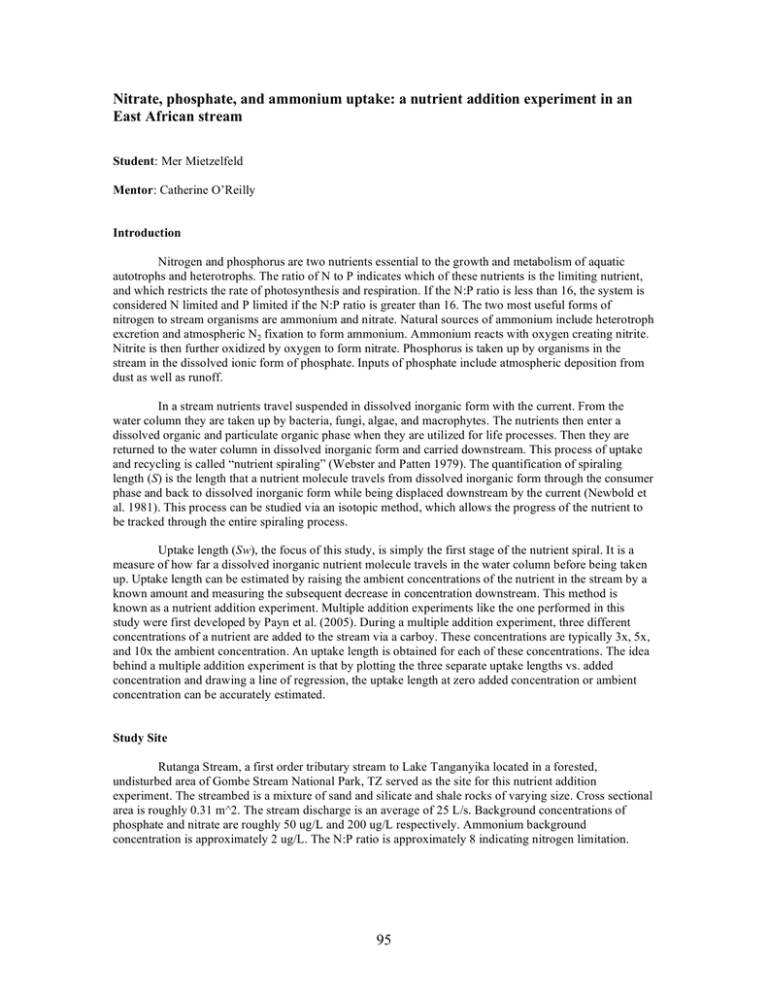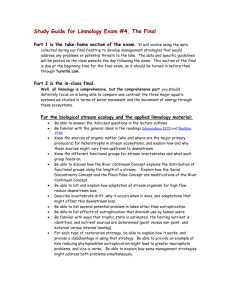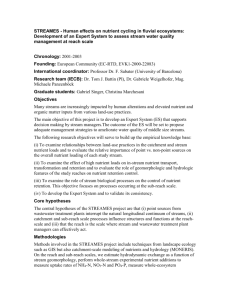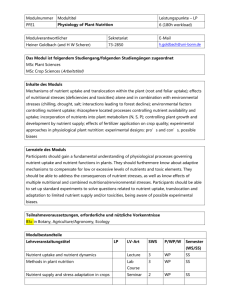Nitrate, phosphate, and ammonium uptake: a nutrient addition experiment in... East African stream
advertisement

Nitrate, phosphate, and ammonium uptake: a nutrient addition experiment in an East African stream Student: Mer Mietzelfeld Mentor: Catherine O’Reilly Introduction Nitrogen and phosphorus are two nutrients essential to the growth and metabolism of aquatic autotrophs and heterotrophs. The ratio of N to P indicates which of these nutrients is the limiting nutrient, and which restricts the rate of photosynthesis and respiration. If the N:P ratio is less than 16, the system is considered N limited and P limited if the N:P ratio is greater than 16. The two most useful forms of nitrogen to stream organisms are ammonium and nitrate. Natural sources of ammonium include heterotroph excretion and atmospheric N2 fixation to form ammonium. Ammonium reacts with oxygen creating nitrite. Nitrite is then further oxidized by oxygen to form nitrate. Phosphorus is taken up by organisms in the stream in the dissolved ionic form of phosphate. Inputs of phosphate include atmospheric deposition from dust as well as runoff. In a stream nutrients travel suspended in dissolved inorganic form with the current. From the water column they are taken up by bacteria, fungi, algae, and macrophytes. The nutrients then enter a dissolved organic and particulate organic phase when they are utilized for life processes. Then they are returned to the water column in dissolved inorganic form and carried downstream. This process of uptake and recycling is called “nutrient spiraling” (Webster and Patten 1979). The quantification of spiraling length (S) is the length that a nutrient molecule travels from dissolved inorganic form through the consumer phase and back to dissolved inorganic form while being displaced downstream by the current (Newbold et al. 1981). This process can be studied via an isotopic method, which allows the progress of the nutrient to be tracked through the entire spiraling process. Uptake length (Sw), the focus of this study, is simply the first stage of the nutrient spiral. It is a measure of how far a dissolved inorganic nutrient molecule travels in the water column before being taken up. Uptake length can be estimated by raising the ambient concentrations of the nutrient in the stream by a known amount and measuring the subsequent decrease in concentration downstream. This method is known as a nutrient addition experiment. Multiple addition experiments like the one performed in this study were first developed by Payn et al. (2005). During a multiple addition experiment, three different concentrations of a nutrient are added to the stream via a carboy. These concentrations are typically 3x, 5x, and 10x the ambient concentration. An uptake length is obtained for each of these concentrations. The idea behind a multiple addition experiment is that by plotting the three separate uptake lengths vs. added concentration and drawing a line of regression, the uptake length at zero added concentration or ambient concentration can be accurately estimated. Study Site Rutanga Stream, a first order tributary stream to Lake Tanganyika located in a forested, undisturbed area of Gombe Stream National Park, TZ served as the site for this nutrient addition experiment. The streambed is a mixture of sand and silicate and shale rocks of varying size. Cross sectional area is roughly 0.31 m^2. The stream discharge is an average of 25 L/s. Background concentrations of phosphate and nitrate are roughly 50 ug/L and 200 ug/L respectively. Ammonium background concentration is approximately 2 ug/L. The N:P ratio is approximately 8 indicating nitrogen limitation. 95 Methods Discharge was measured using the slug-injection method (Gordon et al. 1992). Background concentrations of nitrate and phosphate were found by analyzing water samples using reagents to catalyze reduction reactions and then a spectrophotometer to measure absorbance. The concentration of nutrients in the samples was calculated using a standard graph of known concentrations. Ammonium background samples were analyzed by adding reagents on site and measuring absorbance using a fluorometer. (Holmes et al.1999). The field work for this experiment was carried out in July 2007 during Tanzania’s dry season. The first nutrient addition was ammonium salt (NH4 Cl). Eleven grams of NH4Cl was dissolved in a twenty-liter carboy along with a conservative tracer of NaCl and added to the stream on July 24, 2007. The amount of salt to be added was calculated using a formula in Methods in Stream Ecology (Tank et al. 2006). The background concentration of the stream was raised by 3x, 6x, and 12x for ammonium due to the very low background ammonium concentration. The nutrient concentrations were varied by doubling the drip rate of the carboy beginning with a drip rate of 0.06 L/s. The conductivity was monitored downstream at 60 and 100 meters. When the tracer reached a plateau at the end of the reach, water samples were taken starting from 100 meters and working upstream for each of the three concentrations. At each 20-meter interval three water samples were taken using filter syringes. 5 milliliters of OPA working reagent were added to all ammonium water samples on site. A standard curve was made using water above the drip for each of the three addition concentrations (Taylor et al. 2007). Each curve included a water sample to test for background fluorescence. All samples and standards were measured for ammonium on site within 5 hours using a fluorometer. To measure background fluorescence, 5 milliliters of OPA working reagent were added to the designated samples 30 seconds before they were read. The second addition was carried out on July 30, 2007. A combination of 274 grams of nitrate salt (NaNO3), and 72 grams of phosphate salt (K2PO4) was added to the 20 L carboy with the conservative tracer. This added salt raised the ambient concentration of the stream by 2x and the drip rate was doubled twice to increase the concentration to 4x and then to 8x. The protocol for this addition was the same as that of ammonium except that a 200-meter reach was used instead of a 100-meter reach. The nitrate and phosphate samples were taken back to the lab and frozen until being analyzed by the spectrophotometric method. Using the data from these two additions, the natural log of nutrient concentration minus background concentration divided by difference in recorded and background conductivity vs. distance was plotted on graphs to determine whether the concentration significantly decreased downstream as a result of uptake. The slope of the graph produced by these measurements showed uptake rate. The inverse of this slope is the uptake length. Results All of the ammonium additions showed erratic trends of decreasing then increasing downstream. During the 3x addition, the concentration of ammonium increased rather than decreased downstream, and the 6x addition showed an odd peak of ammonium half way down the reach. The graph of downstream ammonium concentrations for the 12x ambient addition is shown in figure 1. The regression line shows a slight downward trend overall, but there is no gradual decrease from upstream to downstream (p = 0.35). There was also no visible uptake of nitrate in any of the additions. The 2x ambient nitrate addition actually showed an increasing trend from upstream to downstream. A graph of the 8x nitrate addition shows no trend at all with a p-value of 0.84 (see figure 2). Additions of phosphate however did reveal a trend of uptake best seen at the 8x added concentration with a significant p-value of 0.02 (see figure 3). An uptake length of 555.5m was calculated for phosphate using the inverse slope of this graph. The 2x phosphate addition did not show any trend of decrease and 4x addition showed only a slight decreasing trend, but without a significant p-value. 96 Figure 1: Ammonium addition at x12 ambient concentrations. The x-axis shows distance downstream and the y-axis shows the natural log of background and conductivity corrected nutrient concentration (R2 = 0.2188) (p = 0.35). Error bars show standard error. Figure 2: Nitrate addition at x8 ambient concentration. The x-axis shows distance downstream and the yaxis shows the natural log of background and conductivity corrected nutrient concentration (R2 = 0.0112) (p = 0.842). Error bars show standard error. Figure 3: Phosphate addition at x8 ambient concentration. The x-axis shows distance downstream and the y-axis shows the natural log of background and conductivity corrected nutrient concentration (R2 = 0.7903) (p = p=0.0178). Error bars show standard error. 97 Discussion The Rutanga is a nitrogen-limited stream. Therefore, it was expected that both ammonium and nitrate would be measurably taken up. Within a 100-meter reach ammonium concentrations did not decrease significantly after the addition. Then, within a reach twice as long (200 meters), nitrate concentrations did not decrease significantly either. Autotrophs and heterotrophs prefer ammonium to nitrate as a source of nitrogen (Dodds and Priscu 1989; Kirchman 1994). An ammonium addition was not attempted in a 200-meter reach due to time constraints. There may have been visible uptake of ammonium if the reach had been longer. Ensign and Doyle (2006) found significant differences between the uptake of ammonium and the uptake of nitrate comparing fifty-two papers of nutrient spiraling data. Phosphate was the only nutrient measurably taken up in this experiment. This was surprising given the nitrogen-limitation in the stream. The uptake length was of phosphate was calculated as 555.5 meters. However, only the 8x ambient concentration addition showed a significant slope of decrease downstream. This measure of uptake length is probably an over-estimate. It is much higher than the uptake length of phosphate in a woodland stream in Tennessee measured by Newbold et al. (1983) in an isotopic study. They found an uptake length of 190 meters for phosphate in a 124-meter reach of this woodland stream. The background concentration of phosphorus in the Rutanga is about four times greater than in the Tennessean stream. Thus, phosphate may be more limiting to this stream resulting in a shorter uptake length. It may also be that temperate streams have shorter uptake lengths than tropical streams at certain points in the year. The dry season in Tanzania is less productive than the wet season. Many trees lose their leaves and grasses go into dormancy due to lack of water. During these nutrient addition experiments the factor most difficult to control was the drip rate of the carboy. Despite a rubber stopper with tubing to allow airflow, inserted into the top, the set drip rate would decrease significantly in the span of only a few minutes. The drip rate was therefore checked and reset every few minutes throughout all of the additions. Conductivity meters were used to keep track of the variations in drip rate as the water samples for each concentration were taken. The variable drip rate affected the accuracy of the uptake measurements. For example at every concentration in the ammonium addition, the conductivities varied by 3-4 uS/cm. The conductivity followed a trend of higher at 0 meters to lower at 100 meters. The conductivity in the combination nitrate, phosphate addition varied as well by 2-3 uS/cm. For this reason, the concentrations were corrected for conductivity by dividing the calculated concentrations by the difference in recorded and background conductivity. However, the variation in conductivity throughout the experiment could have influenced the biota. If suddenly there was more or less of a nutrient available, the metabolism of the organisms could have changed (Stelzer and Lamberti 2001). Nutrient addition experiments do not provide data on uptake as accurately as the isotopic tracer method. Adding nutrients changes the natural biochemistry of the stream. Elevating ambient concentrations of nutrients may increase the metabolism of the biota, leading to greater uptake rates. Mulholland et al. (1990, 2002) found that nutrient additions affect measurements of uptake length. Nutrient additions tend to overestimate the normal uptake length of the stream because the ecosystem may be saturated with the nutrient. The lack of significant downstream decrease of added nutrients ammonium and nitrate in this experiment could be indicative of a saturated system or of nutrient recycling of nitrogen occurring in algal beds. In this experiment water samples were collected every 20 meters. It would have been more precise to measure every 10 meters, but due to limited time and nutrient salts this was not possible. This project did not provide a great deal of insight into the ambient uptake of nutrients in the Rutanga. In order to more accurately estimate uptake of nutrients at ambient concentrations, it is necessary to have significant data at all three concentration levels. The three uptake length points for each added concentration may then be plotted vs. distance downstream. A regression line drawn through these points back to zero added concentration would give a better estimate of ambient uptake length (Payn et. al 2005). 98 Acknowledgements This project would not have been possible without the field assistance of Dr. Catherine O’Reilly and Derek West. Dr. O’Reilly also gave much academic consultation. My thanks go to Walker Pett for help with preparation work. Our Tanzanian host institute TAFIRI allowed us to use their lab space, and TAFIRI electrician Issa Kassa provided technical support and boat maintenance. The University of Dar Es Salaam greatly assisted us in obtaining research permits. The Office of the Dean at Bard College gave generous funding for supplies. Much of the travel expenses of this project came from NSF grants #’s ATM 0223920 and DBI-0608774. References Ensign, S. H., and M. W. Doyle. 2006. Nutrient spiraling in streams and river networks. Journal of Geophysical Reach. 111. Gordon, N. D., T. A. McMahon, and B. L. Finlayson. 1992. Stream hydrology. An introduction for ecologists. John Wiley and Sons, Chichester, UK. Hall, R. O. Jr., and J. L. Tank. 2003. Ecosystem metabolism controls nitrogen uptake in streams in Grand Teton National Park, Wyoming. Limnology and Oceanography. 48(3): 1120-1128. Tank, Bernot, and Rosi-Marshall 2005 Nitrogen Limitation and Uptake In: Hauer, R. F., and Lamberti, G. A. (eds), Methods in Stream Ecology pp. 213-236. Newbold, J. D., and others. 1983. Phosphorus Dynamics in a Woodland Stream Ecosystem: A Study of Nutrient Spiraling. Ecology: 64(5): 1249-1265. Payn, R. A., and others. 2005. Estimation of stream nutrient uptake from nutrient addition experiments. Limnology and Oceanography: Methods 3: 174-182. Stelzer, R.S. and G.A. Lamberti. Effects of N:P ratio and total nutrient concentration on stream periphyton communitry structure, biomass, and elemental composition. 2001. Limnology and Oceanography 46: 356367. Taylor, B. W., and others. 2007. Improving the fluorometric ammonium method by accounting for matrix effects with standard additions. Dept. of Ecology and Evolutionary Biology Cornell, NY. Webster, J.R., and B.C. Patten. 1979. Effects of watershed perturbation on stream potassium and calcium dynamics. Ecological Monographs 19: 51-72. 99 100






